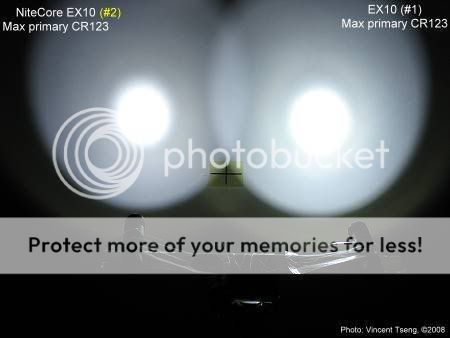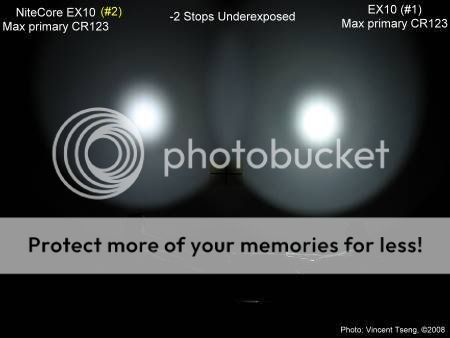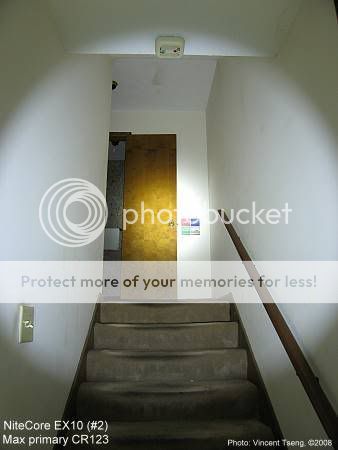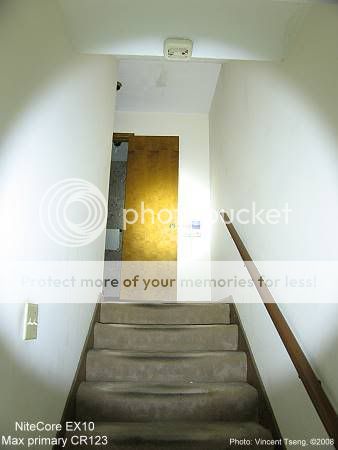Through the very kind courtesy of 4sevens I have on loan 2 samples of the NiteCore EX10.
Why 2? ....... long story -
Short version -
Preface -
The first sample of the EX10 - seemed every bit as bright as (if not brighter than) the NiteCore Extreme (rated at 190-200 lumens)
(I discussed this in NiteCore Extreme (NEX) Comparison Review).
This led me to start a thread -
NiteCore Lumens Rating where some pretty interesting discussion took place - I found myself scrambling to try to show
(a) there wasn't much difference btween the EX10 and the Extreme - and (b) that a 60 lumens difference ought to be visible, and discernable in photos.
I was also aware of other reviews and reports/measurements that seem to indicate the EX10 was not as bright as the Extreme -
contrary to what I was seeing with my sample.
During my beamshots of this review the first sample of the EX10 would switch Off unexpectedly - obviously a fault -
I think it could be from over-heating as the light was being used on Max - and the light did get noticably warm-hot - hot enough to be noticable - but not too hot to hold.
Leaving the light off for a few minutes (to cool down?) - the EX10 worked again at the same level of brightness.
This fault has only just developed/discovered - I had been using that first sample of the EX10 on Max for plenty of beamshots over the course of at least the last 2 weeks.
So I got hold of another sample of the EX10 from 4sevens - who went out of his way to get it to me - despite of his very tight time schedule (thank you David).
There was quite a difference between the brightness of the second sample of the EX10 and the first one.
Side-by-side comparison beamshots -


Standardized stairway beamshots -


I am reviewing the second (not as bright) sample -
because I feel it is more typical of the EX10 -
I think the first sample (of one) I had is probably an anomoly of being extra bright, plus it was faulty -
(for lots of comparison beamshots of the first brighter sample please see -
NiteCore Lumens Rating )
Comparison Review -
size -

head -

Max brightness level using primary CR123 -
vs. NiteCore Extreme (NEX) also on Max and primary CR123 -


pretty obvious Extreme is brighter than the EX10.
vs. NiteCore D10 on Max - Li-Ion 14500


not surprising from the above comparison that the EX10 is not as bright as the D10 on Li-Ion 14500.
vs. Fenix P2D-Q5 on Turbo/max using primary CR123


hmmmm..... this all seems pretty "negative" since all the lights are brighter in comparison - so what is it similar to?
vs. NiteCore D10 on Max - NiMH


this is more like it - pretty comparable - although there are probably absolute measurable differences - probably in any real-world practical usage there would be very little difference.
OK since the D10 seems to perform so much brighter on Li-Ion (14500) -
is the EX10 on Li-Ion 3.7V rechargeable RCR123 brighter?
vs. NiteCore Extreme (NEX) on Max and primary CR123 (as a control)


nope - the EX10 does not seem any brighter on Li-Ion RCR123 when compared to the Extreme (primary CR123) as a control - this set of beamshots look about the same as the primary CR123 set above.
Obviously I wish the EX10 were as bright as the first sample I had - but that was probably an anomoly - that fact that one also turned out to be faulty probably means it is not typical.
The second sample I reviewed here would, on the surface, seem "disappointing" -
but overall - its form-factor, build quality and even output are very pleasing. It is a very nice flashlight.
Index to follow up parts -
Comparison with more closely rated lights in Post #3
Comparison with first EX10 (#1) on Minimum level - Post #7
Comparison on Minimum level Post #21
Why 2? ....... long story -
Short version -
Preface -
The first sample of the EX10 - seemed every bit as bright as (if not brighter than) the NiteCore Extreme (rated at 190-200 lumens)
(I discussed this in NiteCore Extreme (NEX) Comparison Review).
This led me to start a thread -
NiteCore Lumens Rating where some pretty interesting discussion took place - I found myself scrambling to try to show
(a) there wasn't much difference btween the EX10 and the Extreme - and (b) that a 60 lumens difference ought to be visible, and discernable in photos.
I was also aware of other reviews and reports/measurements that seem to indicate the EX10 was not as bright as the Extreme -
contrary to what I was seeing with my sample.
During my beamshots of this review the first sample of the EX10 would switch Off unexpectedly - obviously a fault -
I think it could be from over-heating as the light was being used on Max - and the light did get noticably warm-hot - hot enough to be noticable - but not too hot to hold.
Leaving the light off for a few minutes (to cool down?) - the EX10 worked again at the same level of brightness.
This fault has only just developed/discovered - I had been using that first sample of the EX10 on Max for plenty of beamshots over the course of at least the last 2 weeks.
So I got hold of another sample of the EX10 from 4sevens - who went out of his way to get it to me - despite of his very tight time schedule (thank you David).
There was quite a difference between the brightness of the second sample of the EX10 and the first one.
Side-by-side comparison beamshots -


Standardized stairway beamshots -


I am reviewing the second (not as bright) sample -
because I feel it is more typical of the EX10 -
I think the first sample (of one) I had is probably an anomoly of being extra bright, plus it was faulty -
(for lots of comparison beamshots of the first brighter sample please see -
NiteCore Lumens Rating )
Comparison Review -
size -

head -

Max brightness level using primary CR123 -
vs. NiteCore Extreme (NEX) also on Max and primary CR123 -


pretty obvious Extreme is brighter than the EX10.
vs. NiteCore D10 on Max - Li-Ion 14500


not surprising from the above comparison that the EX10 is not as bright as the D10 on Li-Ion 14500.
vs. Fenix P2D-Q5 on Turbo/max using primary CR123


hmmmm..... this all seems pretty "negative" since all the lights are brighter in comparison - so what is it similar to?
vs. NiteCore D10 on Max - NiMH


this is more like it - pretty comparable - although there are probably absolute measurable differences - probably in any real-world practical usage there would be very little difference.
OK since the D10 seems to perform so much brighter on Li-Ion (14500) -
is the EX10 on Li-Ion 3.7V rechargeable RCR123 brighter?
vs. NiteCore Extreme (NEX) on Max and primary CR123 (as a control)


nope - the EX10 does not seem any brighter on Li-Ion RCR123 when compared to the Extreme (primary CR123) as a control - this set of beamshots look about the same as the primary CR123 set above.
Obviously I wish the EX10 were as bright as the first sample I had - but that was probably an anomoly - that fact that one also turned out to be faulty probably means it is not typical.
The second sample I reviewed here would, on the surface, seem "disappointing" -
but overall - its form-factor, build quality and even output are very pleasing. It is a very nice flashlight.
Index to follow up parts -
Comparison with more closely rated lights in Post #3
Comparison with first EX10 (#1) on Minimum level - Post #7
Comparison on Minimum level Post #21
Last edited:












